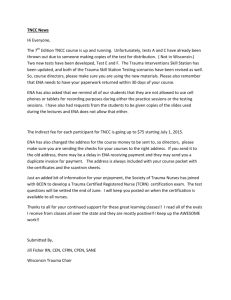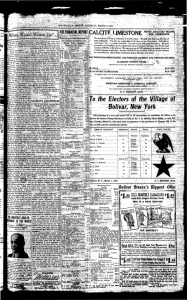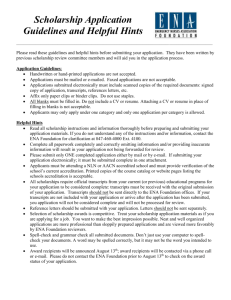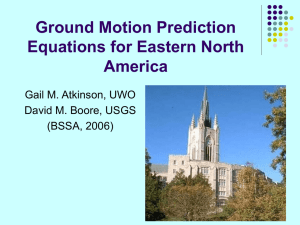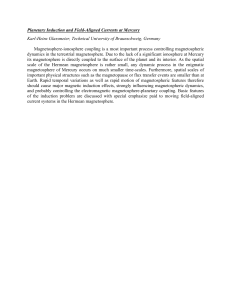Extracting Evolving Structures from Global Visualization
advertisement
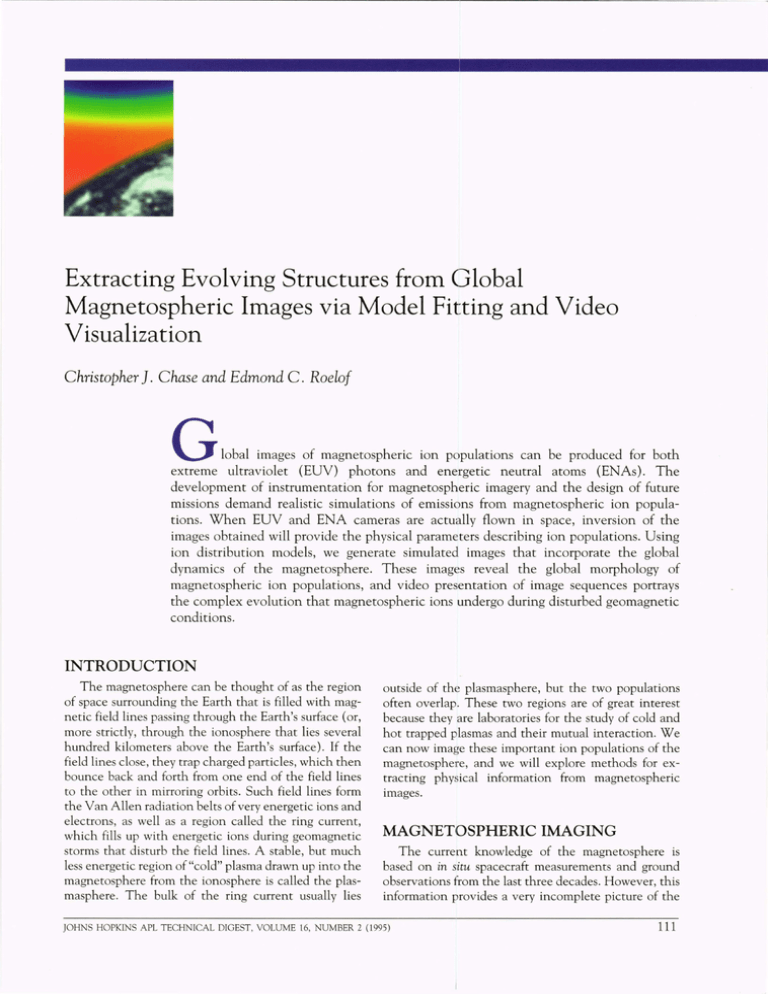
Extracting Evolving Structures from Global
Magnetospheric Images via Model Fitting and Video
Visualization
Christopher]. Chase and Edmond C. Roelof
G
lobal images of magnetospheric ion populations can be produced for both
extreme ultraviolet (EUY) photons and energetic neutral atoms (ENAs). The
development of instrumentation for magnetospheric imagery and the design of future
missions demand realistic simulations of emissions from magnetospheric ion populations. When EUY and ENA cameras are actually flown in space, inversion of the
images obtained will provide the physical parameters describing ion populations. Using
ion distribution models, we generate simulated images that incorporate the global
dynamics of the magnetosphere. These images reveal the global morphology of
magnetospheric ion populations, and video presentation of image sequences portrays
the complex evolution that magnetospheric ions undergo during disturbed geomagnetic
conditions.
INTRODUCTION
The magnetosphere can be thought of as the region
of space surrounding the Earth that is filled with magnetic field lines passing through the Earth's surface (or,
more strictly, through the ionosphere that lies several
hundred kilometers above the Earth's surface). If the
field lines close, they trap charged particles, which then
bounce back and forth from one end of the field lines
to the other in mirroring orbits. Such field lines form
the Van Allen radiation belts of very energetic ions and
electrons, as well as a region called the ring current,
which fills up with energetic ions during geomagnetic
storms that disturb the field lines. A stable, but much
less energetic region of "cold" plasma drawn up into the
magnetosphere from the ionosphere is called the plasmasphere. The bulk of the ring current usually lies
outside of the plasmasphere, but the two populations
often overlap. These two regions are of great interest
because they are laboratories for the study of cold and
hot trapped plasmas and their mutual interaction. We
can now image these important ion populations of the
magnetosphere, and we will explore methods for extracting physical information from magnetospheric
images.
MAGNETOSPHERIC IMAGING
The current knowledge of the magnetosphere is
based on in situ spacecraft measurements and ground
observations from the last three decades. However, this
information provides a very incomplete picture of the
JOHNS HOPKINS APL TECHNICAL DIGEST, VOLUME 16, NUMBER 2 (1995)
111
C.]. CHASE AND E. C. ROELOF
global nature of the magnetosphere because of the
many complex and distributed processes that playa role
in its dynamics. Indirect measurements of the global
magnetosphere would be invaluable in increasing the
limited information obtained so far.
Global imaging of the magnetosphere is possible via
two experimental techniques: extreme ultraviolet
(EUV) imaging and energetic neutral atom (ENA)
imaging. Both types of observations have already been
obtained from crude imaging experiments, such as He +
images from Space Test Program 72-11 and ENA
(> 25 ke V) images from International Sun- Earth
Explorer-I. 2 Although these images did not contain
detailed information on the magnetosphere, they
served as proof-of-concept experiments to support the
type of imaging we envision. The focus of the work
described in this article is ENA imaging, but the techniques also apply equally to EUV imaging.
ENA imaging measures the fast neutral atoms produced when singly charged energetic ions have a
charge-exchange interaction with the cold hydrogen
atoms of the Earth's exosphere. The ions gyrate as they
move along the magnetic field lines. These ions bounce
back and forth between mirror positions on the field
lines until they encounter an exospheric hydrogen
atom. The ion becomes a fast neutral atom when it
strips an electron from the hydrogen and then is no
longer confined along the magnetic field lines. Because
of the very high energy of the ion, it continues along
the same path that it had at the instant of the interaction with essentially no loss in energy. Magnetospheric ENA emissions are optically thin, that is, we
can ignore absorption due to reionization between the
source and the observer. Thus, the stream of neutral
atoms reaching an observer along some line of sight is
a simple sum of all fast neutral atoms produced along
that line that are directed back toward the observer.
The ENA emissions can be detected with a sensitive
energetic particle detector that uses electrically charged
plates to reject the local energetic ions. Such an instrument is effectively an ENA camera. The ENA camera
images the energetic (> 1 ke V) ions that populate the
so-called ring current and plasmasheet regions of the
magnetosphere. Technical details of ENA imager designs can be found in Keath et al} Hsieh and Curtis,4
and McComas et a1. 5 It should be noted that an ENA
imager is actually a particle counter within discrete
angular sectors rather than an optical telescope collecting scattered photons from sunlight, as happens with
EUV imaging.
IMAGING FUNDAMENTALS
The concepts of magnetospheric imaging and their
historical development over the past 20 years may be
found in two recent review articles. 6,7 A model for EUV
112
or ENA imaging begins with the intensity impinging
upon an instrument at position r from a direction u of
photons at wavelength 'A or ENAs with energy E. The
relationship between the EUV irradiance 47rI, measured in Rayleighs (10 6 photons'cm- 2's- 1), and the
density n atom of the atoms (which may be ionized)
involves the g-function, which gives the number of
solar photons resonantly reradiated per second by each
atom at wavelength 'A. In the simplest case, the gfunction depends only on the electronic structure of the
atom and the intensity at the center of the solar line.
This relationship holds true only when the reradiating
atoms have relatively small thermal velocities, that is,
when the solar line, which has a finite width, is not
appreciably Doppler shifted in the atom's rest frame.
The relationship between the ENA unidirectional differential intensity iENA (cm 2·sr·s·keV)-1 at an energy E
and the corresponding energetic ion intensity h ON involves the energy-dependent charge-exchange cross
section (J (cm2) and the exospheric H-atom density nH'
The cross section can be interpreted as the probability
of a charge exchange occurring.
In the "optically thin" case where we can neglect
any reabsorption of the EUV photon or the ENA between the emission point and the spacecraft, the measured intensities may be expressed as line integrals over
the emissions:
47rIEUy (r, A., u) = g('A) f n atom (r - us) ds,
(1)
o
f
jENA (r, E, u) = (J(E) nH (r - us)jION(r - us, E, -u) ds. (2)
o
The line integrals run from the spacecraft position r to
00 along the look direction (-u) opposite to that of the
arriving EUV photon or ENA. Comparing Eq. 1 with
Eq. 2, one sees that the ENA inversion problem is
usually the more complex one. However, if the EUV
reradiation comes from atoms with relatively large
thermal velocities such that some atoms "see" the solar
photons significantly Doppler shifted, then the EUV
inversion is even more complex than the ENA inversion because the atom velocity distribution at each
point along the line of sight must be convolved with
the shape of the solar line. This inversion is too complicated for us to explore in this article. Consequently,
for the remainder of the article, we shall discuss the
general ENA problem of Eq. 2. The reduction to the
simplest EUV case ("cold" atoms) described by Eq. 1
is obvious: simply set h ON in Eq. 2 equal to a constant,
and let nH have the spatial dependence of the EUVemitting atoms.
JOHNS HOPKINS APL TECHNICAL DIGEST, VOLUME 16, NUMBER 2 (1995)
GLOBALMAGNETOSPHERIC IMAGES
The energy dependence of a(E·) is critical in ENA
imaging. Its value is about 10- 15 cm 2 at E = 10 keY for
both energetic H+ and 0 + incident on neutral H.
However, the value plummets to 10- 17 cm 2 for 100-keY
protons, whereas it drops by only a factor of 2.5 down
to 4 X 10- 16 cm 2 for 100-keY 0 +. The spatial dependence of nH(r) was measured over a 4-year period by
the far-ultraviolet imager on the DE-1 spacecraft. 8 The
exospheric H-atom density nH(r) is generally stable at
high altitudes and approximately spherically symmetric. It falls off montonically like a Chamberlin-model
exosphere,9 having a density of 44,000 cm -3 at the
exobase (top of the atmosphere), about 103 cm - 3 at a
radial distance of 2 Earth radii (R E = 6370 km), and
about 10 cm- 3 at 12 RE.
The ENA intensity jENA(r), as measured from a
spacecraft at position r, varies with time for two reasons. First, the ion populations within the magnetosphere can be very dynamic during and immediately
after a solar disturbance. Second, r varies as the instrument moves along its orbit. Indeed, the separation of
spatial gradients from temporal evolution has plagued
the reconstruction of global phenomena using conventional in situ measurements of local fields and particles.
The problem is much less severe with magnetospheric
imaging because the cameras see most of the magnetosphere at any given time.
IMAGE SIMULATION
Modeling and simulation of ENA imaging serves
three purposes. First, it helps to make foreground estimates of jENA' which are essential for ENA imager
design. Second, it allows us to anticipate the potential
information that ENA images contain on the global
distribution of ion intensities, JION ' ENA images are
very rich in information because separate images can
be obtained at many energies over a large energy range
(0.1-100 keY) and for several species of singly charged
ions; H+, He +, and 0 + are the most abundant in the
Earth's magnetosphere. Third, modeling and simulation of ENA imaging allows us to learn how to extract
the global morphological information about magnetospheric dynamics, which is unavailable via in situ measurements. In the next three sections, we will discuss
these purposes of image modeling and simulation.
An actual image is obtained by convolving jENA with
the instrument response function and integrating the
output over the instrument sampling period. The combination of the instrument response and the sampling
integration can be approximated by a tent-like function
over a two-dimensional window (over the space for the
look direction u) that multiplies iENA and then is integrated for each image pixel. For an ideal instrument
with a very high resolution and a short sampling period
relative to the changes in the viewpoint as the instru-
ment spins and moves along its orbit, the resulting
window is approximately a delta function. In this article, we will treat the sampling window as a delta
function that builds up the ENA image by sampling
jENA on a grid corresponding to the angular resolution
(i.e., the window size) of the instrument. See Ref. 2 for
an example of interpreting an actual instrument response function.
Simulating the imaging process requires reasonable
models of the ion population, hON ' in Eq. 2. Typically,
models express hON as a function of L, the radius in RE
of a given magnetic field line where it crosses the magnetic equator. For a dipole field (a good approximation
to the Earth's field at high altitudes), L is a constant
along a magnetic field line. The intensity hON is strongly attenuated inside 2REby charge-exchange losses (the
very process that generates the ENA), so it peaks
around L = 4 and then decays approximately exponentially with increasing L. Consequently, ENA images are
brightest in the inner portions of the magnetosphere,
particularly at low altitudes where the magnetic field
lines approach the Earth (because the exospheric Hatom density increases rapidly with decreasing altitude). However, imaging cameras can be designed to
have sensitivity sufficient to measure ENA intensities
to the outer edge of the ion trapping region (L == 10).
Many researchers have fit various parametric models
to synoptic in situ measurements of the ion intensity
hON by combining intensities measured by the same
spacecraft over many orbits but sorted into bins according to the level of magnetic activity. Alternatively,
nonparametric theoretical models that inherently contain the basic physics of the dynamics of the ion distributions can now be generated by computer codes
that track plasma motions in electric and magnetic
fields. In these plasma simulations, the fields are deduced from synoptic observations sorted into bins by
magnetic activity. In particular, we mention the highly
complex Rice Convection Model lO and its somewhat
simplified derivative, the Magnetosphere Specification
Model (MSM). These two models, developed at Rice
University, calculate the electromagnetic field and
plasma distribution function in the magnetosphere selfconsistently by using multi-fluid magnetohydrodynamical equations with the observed magnetic activity
indices as input. Using the MSM model, we have been
able to obtain simulated images giving insight to potential information that can be provided by future
imaging missions.
FOREGROUND ENA ESTIMATES
The optically thin characteristics of ENA images of
three-dimensional ion distributions are much more
difficult to visualize than images from space of the twodimensional aurora or cloud patterns above the Earth's
JOHNS HOPKINS APL TECHNICAL DIGEST, VOLUME 16, NUMBER 2 (1995)
113
c. J. CHASE AND E. C. ROELOF
surface. Consequently, images of the complex threedimensional structure of the ENA emissions exhibit
considerable variation in intensity and configuration,
depending on the viewing vantage point, so that computer simulation of these images has proved indispensable in setting design requirements for ENA cameras.
Even the estimation of the brightest region in an image
is difficult because of the complex geometry of the ion
distribution. These simulations use models of ion distributions, as discussed previously. Our calculations are
normalized absolutely by the ENA measurements 2 from
the ISEE-1 spacecraft, which showed that, during a
major geomagnetic storm, the maximum intensity for
either 25- 35 keY H or 60- 77 keY 0 would be on the
order of 103 (cm 2·s·sr·keV)-1.
From sets of simulations for different vantage points,
we have extracted the characteristic ranges of intensities (within an order of magnitude) to be expected
during an imaging mission. These intensities are classified according to characteristic structural regions that
have been identified in past ground-based and in situ
measurements, for example, ion-injection boundaries
during geomagnetic storms. Assuming a low instrument
background, we calculated that for the 25- 35 keY H
ENAs, 1% intensity variations during 5 min in the
heart of the storm-time ring current could be detected
within a 1-RE region from a distance of 5 RE. Although
we calculated that it would be difficult to sense remotely 10-20% intensity variations within the outermost
trapping region of this energy band during a 5-min
exposure, they may be more easily measured for lower
energy (1 keY) ENAs. 5 Besides assisting in instrument
design, ENA images can provide quantitative information about the magnetosphere, which we discuss next.
EXAMPLE OF AN ENA IMAGE
We show each ENA image as a pinhole representation, sometimes called a fish-eye view, which is the
same way that the human eye perceives an image. The
pinhole representation is of the line-of-sight intensities
projected on a hemisphere of normalized radius. As
such, an ENA image can be thought of as a polar
intensity plot where the radial distance from the center
of the image is proportional to the polar angle measured
from the view axis, and the clock angle is an angle
measured in some plane perpendicular to the view
direction (e.g., one that contains the magnetic north
direction) .
Figure 1a is an example of a pinhole ENA image. It
is calculated from an MSM run using as inputs the
observed magnetic activity indices measured during the
magnetic storm of 22- 23 May 1988. The instrument
response is emulated by sampling the image on a 2 X 2°
grid and representing the value as a 2 X 2° pixel. The
view is near-polar from about 7.9 RE and 79° magnetic
114
latitude above the dawn meridian looking directly at
the Earth's center. The Sun is therefore to the right.
The white circle is the Earth's limb. North is toward
the top of the image, and dusk is on the left. The
intensities at the outer edge are 90° from the viewing
direction. The black patch in the center is over the
north magnetic pole where the magnetic field lines are
open, so no significant ENA intensities are found there.
The most intense regions surround the hole at the
North Pole at low altitudes, where the exospheric
neutral hydrogen density (nH) is the highest, thus producing the highest ENA intensities jENA according to
Eq. 2. The ENA intensities are highest on the nights ide
and weakest on the days ide during periods of high
activity because ions are energized on the nights ide and
then drift around to the days ide as a result of the
combined effects of the disturbed electric field and the
dipole-like confining magnetic field. The nearly circular outer boundary of the image is an artifact of the
MSM model; no ion intensities are calculated outside
of L = 9.
MEASUREMENT UNCERTAINTY
Noise in actual images is due in part to instrument
background, but it is usually dominated by the variations in the counts of the arriving ENA particle intensity at the instrument. These counting statistics are well
modeled by a Poisson point process. Given the mean
number of counts 'A expected in a given time interval
for a particular look direction u and position r, the
probability distribution of observed counts n is
P(n; 'A) = ('Ane-A)/n! for n = 0, 1, 2, ... ,00. When the
mean number of counts exceeds a moderate size (>20),
the counts approach a Gaussian distribution with mean
<n> = 'A and standard deviation an = 'A1/2. Furthermore,
statistical variations in different pixels are independent; that is, spatially the Poisson variations are statistically uncorrelated or "white." To simulate a noisy
image, we compute the number of counts that would
be sampled in a given pixel by the instrument during
an exposure time Llt for an intensity iENA' which is the
expected number of counts 'A for that image pixel, and
then assign each pixel a random number n selected from
the associated Poisson distribution P(n; 'A).
To illustrate the effects of counting statistics on an
image, we take the ENA image simulated for 30-keV
proton intensities from the MSM shown in Fig. la, and
we introduce the Poisson fluctuations that would occur
in a finite exposure time by varying the expected number of counts n in the brightest 2 X 2° pixel. Figures
1b, 1c, and 1d represent images with peak pixel counts
of 1000, 100, and 10, respectively, which therefore
have >3%, >10%, and >30% uncertainty in the brighter pixels and much greater uncertainty in the dimmer
pixels. The image degradation is minimal in Fig. 1b,
JOHNS HOPKINS APL TECHNICAL DIGEST, VOLUME 16, NUMBER 2 (1995)
GLOBAL MAGNETOSPHERIC IMAGES
- 9.75 X 10-1
9.32 X 10- 1
1.73 X 10-1
1.66 X lO- 1
3.08 X 10-2
2.95 X 10-2
5.48 x 10-3
5.24 X 10- 3
9.75 X 10--4
9.32 X 10--4
No Poisson counting statistics
Maximum counts/pixel
~)
= 1000
~)
- 9.55
Maximum counts/pixel
-
x
10-1
-
1.46
x
10°
1.70 X 10-1
2.60 X 10-1
3.02 X 10-2
4.62 x 10-2
5.37 x 10-3
8.22 x 10-3
9.55 x 10--4
1.46 x 10-3
= 100
Maximum counts/pixel
= 10
Figure 1. Simulated ENA images of 30-keV H+ from 7.9 RE and 79° latitude, generated with 2 x 2° angular resolution. (a) No Poisson
counting statistics. (b )-( d) Effects of Poisson counting statistics for total counts of 1000, 100, and 10, respectively, in the brightest pixel.
Note that even with only 10 counts in the brightest pixel , large-scale morphology is still evident. The color bars are logarithmic, covering
a factor of 1000 in intensity, normalized to the brightest pixel.
and even in the highly degraded image of Fig. ld, the
general morphology is still evident (intensity deficiency
on the days ide compared with the nightside).
EXTRACTION OF ION INTENSITY
FROM AN ENA IMAGE
The power of magnetospheric images lies in their
ability to display the global morphology of magnetospheric processes immediately, that is, the where and
when. The images also contain quantitative information on a global scale. In principle, such global information could be gathered from many in situ spacecraft
making point measurements, but the number of such
spacecraft required would be impracticably large
(> 1000).
Although the advantages of global imaging over in
situ sampling are many, the extraction of relevant magnetospheric information from global images is still a
challenging task. Recall that the images are fundamentally composed of integrals along the lines of sight from
the observation point given in Eq. 2. Ultimately, given
measured images from future experiments, we want to
extract or "unfold" features of the distribution of ion
intensities irON in Eq. 2. This is an inversion problem
similar to those commonly encountered in remote sensing experiments. Indeed, inverting this integral equation bears Similarity to tomographic techniques. In
tomography, many scans of an object are made from a
large number of vantage points that essentially cover
the entire space of possible vantage points. It is required
that the scanned object not change during these scans
JOHNS HOPKINS APL TECHNICAL DIGEST, VOLUME 16, NUMBER 2 (1995)
115
C.]. CHASE AND E. C. ROELOF
and that the radiating source be known exactly. In
magnetospheric imaging, the time scales during which
the magnetospheric structures evolve are generally
much shorter than the orbital period of the spacecraft.
Additionally, a calibrated source is not an inherent
parameter. Thus, tomographic inversion techniques are
not applicable.
Instead of tomographic techniques, we have used
techniques that fit a parameterized model of the magnetosphere to the measured images. The parameters of
the model we have implemented describe important
salient morphological features of irON' such as inner and
outer boundaries of the magnetosphere and the variations of these boundaries with respect to magnetic
local time (analogous to the geographic longitude but
with respect to magnetic north).
FORWARD INVERSION THEORY
BASICS
Strictly speaking, image inversion would involve
working backwards from data to obtain the model
parameters. However, a more useful approach in our
case incorporates a technique well known in astronomy
and astrophysics: it involves adjusting the parameters
of the model and working forward by iteration until the
parameters fit the data. Such forward inversion methods attempt to estimate the model parameters that
provide a best fit between simulated model data and the
measurements. Typically, the criterion for measuring
the goodness of the fit can be expressed as a scalar
function of the model output and measurements. This
function is called an error function because it measures
the error between the model and measurements.
One typical criterion for the fit is choosing the
parameters that maximize the probability, or likelihood, of the measurements for the selected parameters.
For our problem, the probability of the measurements
is characterized by the Poisson statistics included in the
imaging model. This method of parameter estimation
is called the maximum likelihood estimate. Another
criterion is the least-squared error, and the corresponding technique is called least-squared-error estimation.
It finds the model parameters that minimize the sumsquared difference between the measurements and the
model data. A variation of this method is the weighted
least-squares estimate, which multiplies the squared
difference error for each data point by an associated
weight before summing. A specific example of this is
the chi-squared measure of goodness of fit. When the
mean counts are large enough that they have Gaussian
statistics, the maximum likelihood estimate is well
known to be equivalent to the weighted least-squarederror estimate, where the weights are the reciprocals of
the variance at each measured image pixel. In this case,
the error function is the same as the chi-squared mea-
116
sure. In addition, other criteria besides the maximum
likelihood estimate and weighted least-squares estimate
are used for evaluating good fits.
Two important difficulties are encountered in forward inversion problems. First, the number of measurements may be so few as to make the inversion problem
indeterminate. In other words, there just are not
enough measurements to distinguish the parameters.
Sometimes, the problem remains indeterminate no
matter how many measurements are taken. In this case,
a different model is probably more relevant to the measurements. Second, the inversion problem may be illconditioned. In this case, the model may not be sufficiently constrained, resulting in an unstable
inversion. Unstable means the inversion is very sensitive to small perturbations in the measurements. One
cannot have very much confidence in the estimates
returned from an unstable inversion.
FORMULATION OF A PARAMETER
EXTRACTION TEST
For our problem, a large number of measurements
are available, and the parametric model we use is highly
constrained. For our data, we use images simulated from
the ion intensities generated from the MSM runs.
These are stand-ins for the actual ENA images we hope
to obtain from future magnetospheric imaging
missions. For the parametric model to be fit to the
simulated data, we choose a simple model for the
distribution of ion intensities irON that characterizes the
large-scale morphological features of the magnetosphere according to observations from past experiments. By attempting to fit only these large-scale
features, our model overcomes some of the inversion
difficulties mentioned previously.
The functional form of the ring-current energetic
ion intensities that we chose for this initial attempt at
automated image unfolding involves 10 parameters.
The two variables are L (constant along a dipole field
line defined in spherical polar coordinates by
r = aL cos 2A, where a = 1RE and A is the geomagnetic
latitude) and the azimuthal angle ¢, measured anticlockwise from the sunward direction, so that ¢ = 0
(the +x axis) is 1200 magnetic local time (MLT),
¢ = 90° (the +y axis) is 1800 MLT, etc. Then we write
(3)
The exponential form is chosen for irON because the
observed intensities vary far too strongly to be described by linear expansions; this form rules out many
of the techniques of image inversion that rely on linear
algebra. For the ¢ dependence, a harmonic expansion
is convenient:
JOHNS HOPKINS APL TECHNICAL DIGEST, VOLUME 16, NUMBER 2 (1995)
GLOBAL MAGNETOSPHERIC IMAGES
A second harmonic expansion of FcP allows us to modulate the intensity in MLT so that we can have a region
of maximum ion intensity, which is observed on the
nights ide of the Earth, as well as a dawn-dusk asymmetry, which is also observed. For the L dependence,
synoptic data compilations suggest the following:
(L - L2)2
12oL~ + (L 2 - L 1) I Lo
+ (1 I 2)(oL2 I Lo)2 - (1/2)(oLl I LO)2
L>Ln
(5)
where LII = LI + oL I ZILo and Ln = Lz + oL zzILo mark
the L values where iION changes smoothly (with continuous slope) from a Gaussian to an exponential
(L = L ll ) and from an exponential to a Gaussian
(L = Ln). In our simplest models, all the coefficients in
FcP and FL are constants, so that jro is a separable
function of Land ¢. However, since the problem is
already nonlinear, separability does not simplify the
inversion problem that much. There is no reason not
to allow F cP to change its shape with L, if kb ¢l, kz, and
¢ z are allowed to depend on L. Likewise, some ¢ dependence can be permitted in the parameters of FL (L I,
oL I , Lz, oL z, and Lo). Figure 2 shows plots of the surface
hON (L, ¢) from four perspectives in which the x and
y axes are rotated 90° in each successive plot. Parameter
values used to generate the surface are given in Fig. 3.
Our initial investigations have been with constant
coefficients in Eqs. 3 through 5. Then the inner and
Figure 2. Ten-parameter model for the global spatial dependence of ion intensity to be used in ~ test against the nonpara~etric Rice
University MSM plasma computer code. The surface representingjloN (L, ¢) from Eqs. 3 through 5 IS shown from four perspectives, each
rotated by 90°.
JOHNS HOPKINS APL TECHNICAL DIGEST, VOLUME 16, NUMBER Z (1995)
117
c. J. CHASE AND E. C. ROELOF
outer transition L values (L II and L22 ) are constant, so
the boundaries of the ring-current distribution are
quasi-axisymmetrical. This model has its limitations,
but because of the MLT modulation in F 4>' it still has
considerable flexibility in describing the gross morphology of the high-intensity regions of the ring current.
The model contains 10 independent parameters: the
absolute normalization of the ion intensity jo, the two
amplitudes and two phases in F4>' and the linear scale
(Lo) and two pairs of Gaussian parameters (L I , oL I , L2,
oL2) in FL'
OPTIMIZATIONAL APPROACHES
For a given error function, an optimal parameter
estimate is one that minimizes the error function. The
error function minimum cannot be found directly except when the model is linear in the parameters (e.g.,
a polynomial fit in regression analysis). If the error
function is nonlinear, the minimum must be solved for
by an iterative process. In our case, the model is always
nonlinear, which leads us to using an iterative method
of minimizing the error function. Many well-known
minimization algorithms are available for this task.
Several issues affect the effectiveness of a chosen
minimization algorithm for solving the inversion problem. Some of these are (1) the number of parameters,
(2) the computational expense of computing the model, (3) the nonconvexity of error (i.e., the presence of
many shallow local minima in the objective function),
and (4) parameter constraints. Issues 1 and 2 affect the
length of time required by a minimization algorithm to
find a solution. Because there are practical bounds on
how long we are willing to wait to find a solution, it
may be important, depending on the minimization
algorithm chosen, to limit the number of parameters
and the number of model evaluations. Issue 3 affects the
ability of many algorithms to find the best answer to
the inversion problem, and issue 4 may not be applicable to many types of algorithms or may be difficult
to implement.
Optimization algorithms can be either derivative or
nonderivative techniques. Derivative techniques converge faster to a solution but require direct computation
of the objective function derivative. In many problems,
~ucq as ours, the derivative cannot he computed directly but must instead be approximated by using finitedifference formulas. Derivative techniques often use a
steepest descent to move "downhill" in the direction of
the gradient, or they attempt to approximate the objective function locally as a quadratic surface in the
parameter pace and step toward the approximated
minimum directly. Stochastic analogs of these algorithms, for example, simultaneous-perturbation stochastic approximation, II attempt to avoid the large
118
number of forward-model calculations incurred by
finite-difference methods in estimating the gradient
data as the algorithm steps along its search path.
Some nonderivative methods attempt line searches
over a spanning set of directions. These nonderivative
methods are very slow, requiring large numbers of steps
to converge to a minimum. If computation of the forward model and thus the objective function involve
many operations, then these methods are extremely
time-consuming. Common examples of these methods
are the Powell conjugate direction algorithm, the
downhill simplex, and simulated annealing. Simulated
annealing is actually a statistical algorithm that can
take random steps that increase the objective function.
The advantage is that simulated annealing can avoid
local minima at a cost of much slower convergence.
To date, we have only used versions of the Powell
algorithm for inversion of ENA images. Because our
model can contain 20 to 30 parameters, depending on
the order of the harmonic expansions used, and because
the exponential-like line integrals of the forward model
can be computationally expensive, our inversion algorithm is very slow. We provide an example in the next
section. We have begun to investigate other techniques
that may be more robust to initial conditions, for example, the downhill simplex, or faster in requiring
fewer evaluations of the forward model, for example,
the stochastic approximation method.
RESUL TS OF A PARAMETER
EXTRACTION TEST
In this section, we give an example of ENA image
inversion. 12 The data image was generated nonparametrically from the Rke MSM model for 30-keV protons (H+), which, in this case, simulates the main phase
of the geomagnetic st~rm in May 1988. Another (more
polar), ENA image of the same storm-time ion distribution was shown in Fig. 1a. Figure 3a shows a pinhole
view of the data image from about 3 RE at 60 N geomagnetic latitude in the dawn meridian looking at the
center of the Earth. North is toward the top center, and
the white circle defines the Earth's boundary. The color
bar shows the normalized ENA intensities on a linear
scale. The intensities for the image were generated on
a 4 X 4° grid.
We note the obvious buildup in the image on the
nightside as expected, whereas excess intensities in the
dusk sector might actually be due to deceptive line-ofsight projection effects. By inspection, we can estimate
the outer extent of the protons at roughly 4 RE• However, the inner exteI).t of the protons is impossible to
deduce without image inversion because that region is
obscured by emissions from protons on field lines farther out than the innermost one. Our example inver0
JOHNS HOPKINS APL TECHNICAL DIGEST, VOLUME 16, NUMBER 2 (1995)
GLOBAL MAGNETOSPHERIC IMAGES
sion demonstrates that gross morphological properties
such as the inner boundary of the protons can be quantitatively extracted from the image.
In this example, we used the Powell minimization
method to determine the least-squared-error estimate
for the ion intensity parameters based on the 10-parameter version of jION given in Eqs. 3 through 5. Using an
unweighted least-squared-error function favors fitting
our intensity model more closely to the brighter regions
of the image. The inversion required 216 evaluations
of the forward model over three complete iterations of
the Powell algorithm (an iteration consists of line
search minimizations over a spanning set of directions
in the parameter space).
Figure 3b is the simulated ENA image reconstructed
using the estimated parameters returned by the image
inversion. Notice that the shapes of the brightest regions in both images are very similar and that their
1.5
(a)
MLT = 0000
MLT = 0600
MLT = 1200
MLT = 1800
2'
·c
:::l
".!:::!
Q)
1.0
(ij
E
0
.s
z
0
.-==~
.ii5
c 0.5
Q)
.~
c
.Q
ENA intensity (normalized units)
0
0.003 0.067 0.130 0.194 0.258
I
I
I
I
0
2
4
6
L (dipole) (RE)
I
0.003 0.068 0.134 0.199 0.265
ENA intensity (normalized units)
1.5
(b)
MLT = 0000
MLT = 0600
MLT = 1200
MLT = 1800
2'
·c
:::l
".!:::!
Q)
1.0
(ij
L1 = 3.04
oL1 = 0.27
L2 = 4.81
oL2 = 0.12
La = 1.34
k1 = 0.96
k2 = -0.25
¢1=115°
¢2 = 90°
E
0
.s
z
0
.-==~
.ii5
c 0.5
Q)
.~
c
.Q
OL-__________
o
~~
________
2
_ L_ _ _ _~~_ _~
4
6
L (dipole) (RE)
Figure 3. (a) ENA "data" image from 3 RE and 60° geomagnetic latitude simulated from a 30-keV H+ distribution derived from a non parametric
MSM run using inputs from the geomagnetic storm of 22-23 May 1988. The color bar is logarithmic (factor of 100). (b) ENA image reconstructed
from an optimal set of 10 parameters extracted by optimizing the fit to the model given by Eqs. 3 through 5. To the right of each image are
corresponding plots of jlON versus L for four magnetic local times. Note the general agreement of peak ion intensities at all magnetic local times.
(Adapted from the analysis of Roelof et a1. 12)
JOHNS HOPKINS APL TECHNICAL DIGEST, VOLUME 16, NUMBER 2 (1995)
119
C.]. CHASE AND E. C. ROELOF
absolute magnitudes, as indicated by the maximum of
the color bar, are very well reproduced. Thus, the inversion has replicated the two-dimensional image.
However, the more important question is whether the
features of the three-dimensional distribution of the
ions (hON) that produced the two-dimensional ENA
image have been captured properly by the inversion.
We can answer this question by comparing hON of
our model with the ion intensities of the MSM model.
To the right of each image in Fig. 3 are plots of hON
versus L for midnight (0000 MLT), dawn (0600 MLT),
noon (1200 MLT), and dusk (1800 MLT). Examination of the MSM plots (upper panel) shows that most
of the protons were in the dusk-to-midnight sector with
a peak near L = 3 and an inner boundary near L = 2.8.
The dawn sector had the lowest intensities with a narrow peak at L == 4. The noon sector had the most complex profile with an inner edge at L == 3 and an outer
edge at L == 4.
The 10-parameter intensity model does not have the
flexibility to reproduce the detailed features of the
MSM data. For example, because the model is a separable function of Land cj>, the inner and outer L limits
of the ion intensity are constrained to be the same for
all cj>. The effect of this constraint is manifested in the
nearly circular, dark polar region of the reconstructed
image. Nevertheless, the modeled distribution (lower
panel) correctly places the maximum intensities equally
in the dusk and midnight sectors; an inner edge is at
L == 2.5 and a peak occurs at L == 3, in agreement with
the MSM intensities. Additional features are correctly
extracted, such as the next lower peak intensities in the
noon sector and the lowest in the dawn sector.
The parameter extraction was tested on an ideal
image with no Poisson counting fluctuations in the
pixels (infinite exposure time). However, Roelof,
Mauk, and Meier 13 demonstrated that the model and
the procedure described previously were stable and
robust against degradation due to pixel count fluctuations. Specifically, even when only 30 counts occurred
in the brightest pixel (18% fluctuations), the parameters were still extracted to within < 10% on average of
their proper value.
We conclude that the inversion of a single image
successfully extracted the dominant spatial characteristics from the 30-keV proton "data" distribution. The
azimuthal asymmetries were found, as well as the peak
magnitudes and the approximate positions of the outer
and the (not directly visible) inner edges. The simple
model was unable to extract more detailed information.
To extract finer details from actual measurements, we
would (on a real imaging mission) achieve more detail
by simultaneously inverting multiple images from sequential viewing positions along the spacecraft orbit.
The spatial separation would have to be sufficient so
that the images differed significantly. Such a technique
120
would be limited by the time scale for the evolution of
the magnetosphere over the exposure time required to
acquire the images with acceptable counting statistics.
We currently are investigating the optimization of a
more detailed model with respect to sequential images
and have obtained promising results.
VISUALIZING THE DYNAMICS OF
THE MAGNETOSPHERE
We mentioned that image inversion using multiple
images to extract finer details of the ion intensity is
limited by the dynamic evolution of the magnetosphere. However, this dynamic evolution itself is of
great interest. As 30 years of effort has taught us, the
global dynamics of the magnetosphere are not easily
untangled using in situ measurements. Obviously, physically significant cause-and-effect relationships will
stand out in magnetospheric images, and their interpretation will not require strict quantitative inversion.
Consequently, the presentation of successive ENA
image measurements as a "video" will help scientists to
visualize and understand the global magnetospheric
evolution. It will also prove helpful in routine data
analysis. After all, imaging data are really an interrelated sequence of images, not a set of dissociated
independent snapshots.
To demonstrate the usefulness of this concept, we
have simulated such a video for the pioneering Swedish
imaging microsatellite, Astrid. 14 This tiny spacecraft
(25 kg) was launched into a 1000-km circular polar
orbit on 24 January 1995. It carried two different ENA
cameras (0.1- 70 keY surface scattering to a microchannel plate detector and 13-140 keY solid state detector).
To simulate the ENA intensities from this low-altitude
orbit, we again used the Rice MSM runs for the geomagnetic storm of 22-23 May 1988. This time we used
14-keV 0+ intensities as the basis for our simulation.
Figure 4 presents a sequence of three hemispherical
pinhole images from a dawn-dusk orbit at magnetic
latitudes of 50,55, and 60°. The left column shows the
antisunward view, and the right column shows the
sunward view. The limb of the Earth is marked by the
white arc. We have added the ENA upward albedo
expected for oxygen atoms, which will emerge from the
precipitating shower of 0+ dumped downward into the
atmosphere during magnetic disturbances. We have
estimated the albedo from the calulations of Ishimoto,
Romick, and Meng. 15 We have found the orbit videos
invaluable in coping with the convoluted three-dimensional structures of the trapped ion populations as
viewed "inside-out" from low altitude.
Simulating an ENA image movie by producing
every single frame using the MSM and imaging models
is computationally prohibitive. To overcome this dif-
JOHNS HOPKINS APL TECHNICAL DIGEST, VOLUME 16, NUMBER 2 (1995)
GLOBAL MAGNETOSPHERIC IMAGES
ficulty, only a sequence of sample
images was generated from the
models. These images were then
combined to create a movie by using a popular video editing technique called "morphing." These
movies were saved on videocassettes for later study and distribution. Morphing software creates
movies from a sequence of images
by smoothly varying the features of
one image into another. An operator must manually select image
features such as boundaries and
specially shaped regions. These features are then smoothly deformed
from one image to the corresponding features of another. Although
complex morphing can be computation and labor intensive, it was
considerably more practical than
generating each frame directly via
the models. For simulation purposes, this approach proved to be effective and practical. The resulting
image evolution may not agree
with the fine details of the direct
approach, but this is neither apparent nor important when viewing
the video.
CONCLUSION
Figure 4. A sequence of three hemispherical pinhole images from a 1OOO-km dawn-dusk orbit
(similar to the Swedish microsatellite, Astrid) at magnetic latitudes of 50,55, and 60°. The left
column shows the antisunward view, and the right column shows the sunward view. The limb
of the Earth is marked by the white arc. 14-keV 0+ intensities were used as the basis of the
simulation. "Data" from the MSM plasma computer code for 14-keV 0+ were also used to
calculate upflowing neutral oxygen albedo from precipitating energetic 0+ during geomagnetic
disturbances.
This preliminary and exploratory work interpreting magnetospheric images is directed toward
setting requirements for future imager designs and for analyzing the
streams of images produced. The
challenges are great, but the rewards will be grand: visualizations
of the global dynamics of the diverse ion populations trapped in
the Earth's magnetosphere. After
all, these ions are tracers of the
electrical fields and currents that
permeate the Earth's magnetic
field, and EUV and ENA imaging
techniques are our only means of
"seeing" them.
REFERENCES
1 Weller, C. S., and Meier, R. R., "First Satellite
Observations of the He + 304A Radiation and Its
Interpretation," J. Geophys. Res. 79, 1572-1578
(1974).
JOHNS HOPKINS APL TECHNICAL DIGEST, VOLUME 16, NUMBER 2 (1995)
121
C.] . CHASE AND E. C. ROELOF
2 Roelof, E. c., "Energetic Neutral A tom Image of a Storm-Time R ing
Current," Geophys . Res. Lett. 14, 65 2-655 (1987).
3 Keath, E. P., Andrews, G. B., Mauk, B. H., Mitchell, D. G. , and Williams,
D. ]., "Instrumentation fo r Energetic eutral A tom Imaging of Magnetospheres," in Solar System Plasma Physics, G eophysical Monograph 54,
American G eophysical Union, Wash ington, DC, pp. 165- 170 (1989) .
4Hsieh , K. c., and Curtis, C. c., "Remote Sensing of Planetary Magnetospheres: Ma s and Energy A nalysis of Energetic Neutral Atoms," in Solar
System Plasma Physics, G eophy ical Monograph 54, American Geophysical
Union , Washington , DC, pp. 159-164 (1 989).
5 McComas, D. ]., Barraclough , B. L. , Elphic, R. c., Funsten, H . 0 ., III , and
T homsen, M. F., "Magneto pheric Imaging with Low-Energy Neutral Atoms,"
Proc. Nat! . Acad. Sci . U. S.A. 88, 9598-9602 (1 991) .
6Roelof, E. c., and Williams, D. ]., "The T errestrial Ring Current: From in situ
Measurements to G lobal Images Using Energetic Neutral A toms," Johns
Hopkins APL Tech. Dig. 9 (2), 144--163 (1 988).
7Williams, D. ]., Roelof, E. c., and Mitchell, D. G., "Global Magnetospheric
Imaging," Rev. Geophys. 30 , 183- 208 (1992 )
8 Rairden, R. L. , Frank, L. A., and Craven , ]. D. , "Geocoronal Imaging with
Dynamics Explorer," J. Geophys . Res. 9 1, 13,613-13 ,630 (1 986) .
9Chamberlin,] . W ., and Hunten , D. H., Theory of Planetary Atmospheres (2nd
Ed.) , International Geophysics Series, 3 6 , Academic Press, New York (1987).
IOWolf, R. A., Spiro, R. W ., and Rich, F. ]. , "Extension of the Rice Convection
Model into the H igh-Latitude Ionosphere," J. Atmos . Terr . Phys . 53 , 817-J329
(199 1) .
11 Spall, ]. c., "Multivariate Stochastic Approximation Using a Simultaneous
Perturbation G rad ient Approximation ," IEEE Trans . Auto. Control 37 , 332341 (1992) .
12 Roelof, E. c., Mauk, B. H., Meier, R. R. , Moore, K. R. , and Wolf,
R. A. , "Simulations of EUV and ENA Magnetospheric Images Based on the
Rice C onvection Model," Proc . SPIE, Instrumentation for Magnetospheric
Imagery II 2008, 202- 213 (1993).
13 Roelof, E. c., Mauk, B. H., and Meier, R. R. , "Instrument Requirements for
Imaging the Magnetophere in Extreme-Ultraviolet and Energetic Neutral
Atoms Derived from Compute r-Simulated Images," Proc. SPIE, Instrumentation for Magnetospheric Imagery 1744, 19-30 (1992).
14Chase, C. ]., Mauk, B. H., Roelof, E. c., Wolf, R. A., and Spiro, R. W.,
"Energetic Neutral A tom Images of H + and 0+ Ion Distributions Simulated
from Astrid 1000 km Polar Orbit," EOS , Trans . Am . Geophys. Union 75 , 546
(1994) .
151shimoto, M. , Romick, G. J., and Meng, c.-I., "Model C alculation of the N 2+
First Negative Intensity and Vibrational Enhancement fro m Energetic
Incident 0+ Energy Spectra," J. Geophys . Res. 97 , 8653-J3660 (1 992) .
ACKNOWLEDGMENTS: The efforts of both authors were supported in part by
NASA Grants NAGW -2619 and NAGW-4140 to APL. Considerable material in
this article was developed from collaborative work with our valued APL colleagues
Barry H. Mauk, Donald G . Mitchell, and Donald ] . W illiams.
THE AUTHORS
CHRISTOPHER J. CHASE received B.S. degrees in electrical engineering
and mathematics from Brigham Young University in 1987, and M.S. and
Ph.D. degrees in electrical engineering from Princeton University in 1989
and 1992, respectively. Between 1983 and 1988, he was a member of the
Computer Architecture and Sensor System Modeling Departments of The
Aerospace Corporation, El Segundo, California. Dr. Chase is now with
APL's Computer Science and Technology Group, and he is also an active
member of the IEEE. His research interests include dynamical system analysis
and control, discrete event systems, communication networks, image
processing, parameter estimation, and pattern recognition. His e-mail address
is Christopher.Chase@jhuapl.edu.
EDMOND C. ROELOF received his Ph.D. in physics from the University of
C alifornia, Berkeley, in 1966. Before coming to APL, he was a research
scientist at the Boeing Scientific Research Laboratories and at the NASAl
Goddard Space FLight Center, and later he was an Assistant Professor of
Physics at the University of New Hampshire. Dr. Roelof joined APL's Space
Physics and Instrumentation Group in 1974. He has held visiting appointments at NOAA's Space Environment Laboratory, as well as at universities
and institutes in Europe. He h as also served on NASA Management and
Operations working groups and as an officer of the American Geophysical
Union, from which he received the 1987 Editor's Citation for Excellence in
Refereeing (Geophysical Research Letters) . Dr. Roelof is a coinvestigator for
the Ulysses (heliosphere), Galileo (Jupiter), and ISTP (Geotail) missions.
His published research covers topics in energetic particles, plasma, magnetic
fields, and radio emissions in the solar corona, the interplanetary medium,
and the magnetospheres of Earth, Jupiter, and Saturn. His e-mail address is
Edmond.Roelof@jhuapL.edu.
122
JOHNS HOPKINS APL T ECHN ICAL DIGEST, VOLUME 16, NUMBER 2 (1995)
